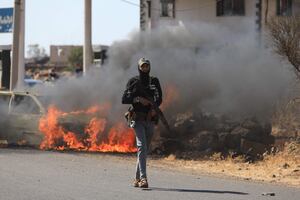In the years leading up to Syria’s revolution, in 2011, more than a million people in the Syrian countryside had fled to its cities as a result of climate-induced drought, creating crises in the agricultural sector and the cost of living. How much this contributed to the revolution and the ensuing 14-year civil war remains a subject of considerable debate. Syrians had many reasons to rise up against the Assad regime, which maintained power for decades through systematic oppression and mass torture. But there is little doubt that the drought had exacerbated an already-combustible situation.
Syria’s new government is proving to be entirely different from its predecessor. Its leader, Ahmad Al Shara, speaks of a tolerant and inclusive new chapter, and his popularity shows most Syrians believe him. But wholesale political change does not make the country’s environmental problems – nor their consequences for stability – go away, as evidenced by a series of wildfires that ravaged Syria’s coastal forests last week.
Thanks to the dedication of the local civil defence workers and volunteers, the fires were contained in 10 days. But, as several of them told The National, the task was arduous – made harder by the sorry state of the country’s post-war infrastructure and the presence of landmines in the area.
Wildfires are becoming a perennial problem for Syrian authorities, worsened by the persistence of drought. The current drought, ongoing since 2021, is even worse than the one in the late 2000s. In the absence of sufficient rainfall, wheat production has declined, this year meeting less than 20 per cent of national demand. Bread prices, as a result, have soared. The lack of rainfall has also contributed to a water crisis in Damascus, the Syrian capital, where authorities have urged residents to reduce consumption.
At the same time, the country’s authorities are struggling to keep a tight lid on sectarian violence. Clashes last weekend between rival factions in the southern city of Sweida left 30 people dead. Since March, violence in the south as well as the north-west has killed more than 1,000 people. The overall level of danger remains a far cry from the civil war years, but one of the chief lessons of that period is that any emergent combination of deadly violence, environmental crisis and economic strain should not be ignored.
Syria’s regional neighbours have pledged to do much to help its fledgling government stabilise the country – in terms of infrastructure, investment and, where needed, diplomatic support. Co-operation should be expanded more vigorously to the realm of the environment. Some countries, like Iraq and Turkey, sent support to battle the recent wildfires but there is a need to act more firmly to confront desertification and all aspects of climate change.
The governments of the Middle East, to be sure, have many other issues to contend with just now. But climate change and its consequences do not wait for wars to wind down or political disputes to be resolved. Co-ordination in this area could be an avenue for building trust and strengthening ties, rather than something to be explored when it is already too late.
Syria’s crisis is particularly acute, but it is not unique to that country. Across much of the Arab world, droughts, wildfires and other environmental threats are proliferating. With them comes a greater risk of volatility. Conversations about how to deal with these issues together should be included in efforts to resolve the region’s other challenges, and the time to have them is now.



